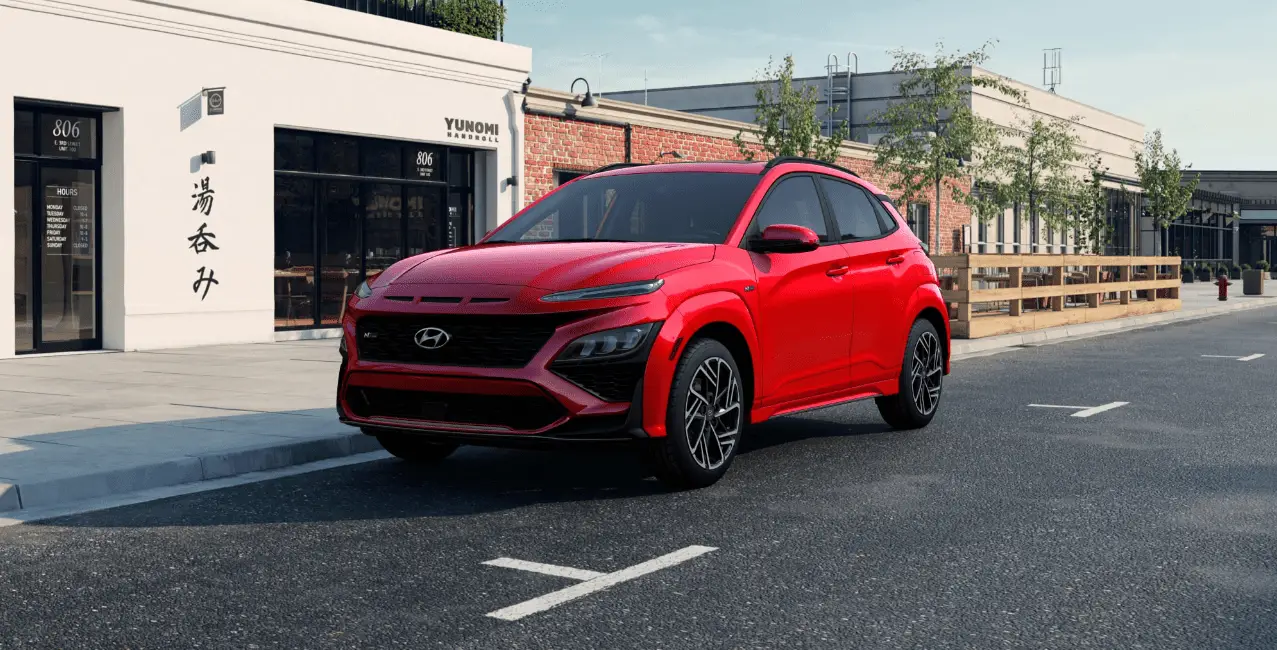Hyundai Kona 2023 Navigation-based Smart Cruise Control (NSCC)
The 2023 Hyundai Kona redefines driving with its ground-breaking navigation-based Smart Cruise Control system. This system uses cutting-edge GPS technology to work in unison with the car’s adaptive cruise control system, enabling it to make proactive speed adjustments based on real-time navigation data. This means that the Kona’s navigation-based smart cruise control optimizes comfort and fuel efficiency while lowering driver stress as you approach curves, intersections, or changes in speed limits. It also considers the upcoming road conditions in addition to maintaining a safe following distance from the vehicle ahead. With its notable advancement in intelligent cruise control technology, the 2023 Hyundai Kona has become a unique vehicle in the small SUV market.
2023 Hyundai KONA Specs, Price, Features, Milage (Brochure)
Navigation-based Smart Cruise Control (NSCC)
Navigation based Smart Cruise Control with curve control can help drive at a certain speed according to the road conditions when driving on highways by using road information from the navigation system while Smart Cruise Control is operating.
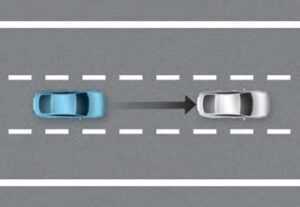
Information
Navigation-based Smart Cruise Control is available only on controlled access roads of certain highways. Controlled access road indicates roads with limited entrances and exits that allow uninterrupted high-speed traffic flow. Only passenger cars are allowed on controlled access roads. Additional highways may be expanded by future navigation updates.
Information
Navigation-based Smart Cruise Control operates on main roads of highways and does not operate on interchanges or junctions.
Highway Curve Zone Auto Slowdown
If vehicle speed is high, the Highway Curve Zone Auto Slowdown function can temporarily decelerate your vehicle or limit acceleration to help you drive on a curve based on the curve information from the navigation.
Highway Set Speed Auto Change
Highway Set Speed Auto Change function automatically changes Smart Cruise Control set speed based on the speed limit information from the navigation.
Function Settings
Setting
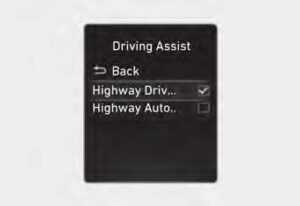
With the engine on, select ‘Driver Assistance Driving Assist Highway on Navigation-based Smart Cruise Control and select turn off the system.
Information
When there is a problem with Navigation-based Smart Cruise Control, the function cannot be set from the Settings menu.
Navigation-Based Smart Cruise Control Operation
Operating conditions
Navigation based Smart Cruise Control with curve control is ready to operate if all of the following conditions are satisfied:
- Smart Cruise Control is operating
- Driving on main roads of highways
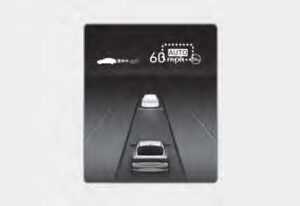
Function standby
If the operating conditions are satisfied, the white indicator will illuminate.
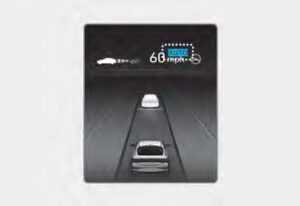
Function operating
If temporary deceleration is required in the standby state and Navigation-based Smart Cruise Control is operating, the green symbol will illuminate on the cluster. If the Highway Set Speed Auto Change function operates, the green symbol and set speed will illuminate on the cluster, and an audible warning will sound.
WARNING
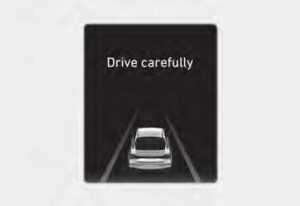
‘Drive carefully’ warning message will appear in the following circumstances:
Navigation-based Smart Cruise Control is not able to slow down your vehicle to a safe speed
Information
The Highway Curve Zone Auto Slowdown and Highway Set Speed Auto Change function use the same symbol.
Highway Curve Zone Auto Slowdown
Depending on the curve ahead on the highway, the vehicle will decelerate, and after passing the curve, the vehicle will accelerate to the Smart Cruise Control set speed. Vehicle deceleration time may differ
Highway Set Speed Auto Change
- The Highway Set Speed Auto Change function will operate when Smart Cruise Control sets the speed and the highway speed limit is matched.
- While the Highway Set Speed Auto Change function is operating, when the highway speed limit changes, Smart Cruise Control set speed automatically changes to the changed speed limit.
- If the Smart Cruise Control set speed is adjusted differently from the speed limit, the Highway Set Speed Auto Change function will be in the standby state.
- If the Highway Set Speed Auto Change function has changed to the standby state by driving on a road other than the highway main road, the Highway Set Speed Auto Change function will operate again when you drive on the main road again without setting the set speed.
- If the Highway Set Speed Auto Change function has changed to the standby state by depressing the brake pedal or pressing the switch on the steering wheel, press the switch to restart the function.
- The Highway Set Speed Auto Change function does not operate on highway interchanges or junctions.
Information
Highway Set Speed Auto Change function only operates based on the speed limits of the highway, it does not work with speed cameras. When the Highway Set Speed Auto Change function is operating, the vehicle automatically accelerates or decelerates when the highway speed limit changes. The maximum set speed for the Highway Set Speed Auto Change function is 86 mph (140 km/h If the speed limit of a new road is not updated in the navigation, the Highway Set Speed Auto Change function may not operate properly. If the speed unit is set to a unit other than the speed unit used in your country, the Highway Set Speed Auto Change function may not operate properly.
Limitations of Navigation-Based Smart Cruise Control
Navigation-based Smart Cruise Control may not operate properly under the following circumstances:
- The navigation is not working properly
- Speed limit and road information in the navigation is not updated
- The map inroads are different because of option and the actual real-time GPS data or map information error
- The navigation searches for a route while driving
- GPS signals are blocked in areas such as tunnel
- The navigation is updated while driving
- Map information is not transmitted due to the infotainment system’s abnormal operation
- A road that divides into two or more roads and joins again
- The driver goes off course on the route set in the navigation
- The route to the destination is changed or canceled by resetting the navigation
- The vehicle enters a service station or rest area
- The speed limit of some sections changes according to the road situations
- Android Auto or Car Play is operating
- The navigation cannot detect the current vehicle position (for example, elevated roads including overpasses adjacent to general roads or nearby roads exist in a parallel way)
- The navigation is being updated while driving
- The navigation is being restarted while driving
- There is bad weather, such as heavy rain, heavy snow, etc.
- Driving on a road under construction
- Driving on a road that is controlled
- Driving on a road that is sharply curved
WARNING
Navigation-based Smart Cruise Control is not a substitute for safe driving practices, but a convenience function. Always have your eyes on the road, and it is the responsibility of the driver to avoid violating traffic s. law The navigation’s speed limit information may differ from the actual speed limit information on the road. It is the driver’s responsibility to check the speed limit on the actual driving road or lane. Navigation-based Smart Cruise Control will automatically be canceled when you leave the highway main road. Always pay attention to road and driving conditions while driving. Navigation-based Smart Cruise Control may not operate due to the existence of leading vehicles and the driving conditions of the vehicle. Always pay attention to road and driving conditions while driving. When you are towing a trailer or another vehicle, we recommend that Navigation-based Smart Cruise Control is turned off due to safety reasons. After you pass through a tollgate on a highway, Navigation-based Smart Cruise Control will operate based on the first lane. If you enter one of the other lanes, the system may not operate properly. The vehicle will accelerate if the driver depresses the accelerator pedal while Navigation-based Smart Cruise Control is operating, and the function will not decelerate the vehicle. However, if the accelerator pedal is depressed insufficiently, the vehicle may decelerate. If the driver accelerates and releases the accelerator pedal while Navigation-based Smart Cruise Control is operating, the vehicle may not decelerate sufficiently or may rapidly decelerate to a safe speed.
- If the curve is too large or too small, Navigation-based Smart Cruise Control may not operate.
Information
A time gap could occur between the navigation’s guidance and when the Navigation-based Smart Cruise Control operation starts and ends. The speed information on the cluster and navigation may differ. Even if you are driving at a speed lower than the Smart Cruise Control’s set speed, acceleration may be limited by the curve sections ahead. If Navigation-based Smart Cruise Control is operating while leaving t Smart Cruise Control may feel it is not sufficient due to road conditions such as uneven road surfaces, narrow lanes, etc. the main road to enter an interchange, junction, rest area, etc., the system may operate for a certain period of time.
Deceleration by Navigation-based
Information
This device complies with Part 15 of the FCC rules.
Operation is subject to the following three conditions:
- This device may not cause harmful interference, and
- This device must accept any interference received, including interference that may cause undesired operation.
- Changes or modifications not expressly approved by the party responsible for compliance could void the user’s authority to operate the device.
Information
Radiofrequency radiation exposure information:
- This equipment complies with FCC radiation exposure limits set forth for an uncontrolled environment.
This equipment should be installed and operated with a minimum distance of 8 in. (20 cm) between the radiator (antenna) and your body. - This transmitter must not be co-located or operating in conjunction with any other antenna or transmitter.
FAQ
The Navigation-based Smart Cruise Control in the 2023 Hyundai Kona is an advanced cruise control system that uses GPS navigation data to enhance the vehicle’s adaptive cruise control functionality.
It uses real-time GPS data to anticipate road conditions, curves, intersections, and speed limit changes. It adjusts the vehicle’s speed accordingly to optimize fuel efficiency and driving comfort.
It may be available as an optional feature or as part of a higher trim package, so it might not be standard on all Kona models.
Yes, the driver can override the system at any time by using the vehicle’s standard controls, such as the brake pedal or accelerator.
It works best on highways and well-mapped roads where GPS data is available. It may not function optimally in off-road or unmapped areas.
Yes, the Navigation-based Smart Cruise Control relies on a consistent GPS signal to function effectively.
Yes, drivers can typically adjust the following distance according to their preferences, within the system’s operational limits.
While it can be used in city driving, it’s primarily designed for highway driving, where constant speed adjustments and lane changes are less frequent.
Depending on the vehicle’s features, it may provide warnings or alerts if it detects a potential collision or if the driver needs to take over control.
It typically does not recognize traffic signals or stop signs on its own. It relies on GPS data and may not respond to these specific road features.
Yes, it can help improve fuel efficiency by optimizing speed and reducing unnecessary acceleration and braking.
Availability may vary depending on the specific trim level and options chosen.
Updates may be possible through software updates provided by the manufacturer or dealer.
Some versions of this system may have safety features like collision avoidance or lane-keeping assist as part of a broader package.
It reduces the need for constant speed adjustments, making long highway drives more comfortable and less fatiguing.
Useful Link
View Full User Guide: Hyundai Kona 2023 User Guide
Download Manuals: https://owners.hyundaiusa.com/us/en/resources/manuals-warranties.html
2023 Hyundai KONA Specs, Price, Features, Milage (Brochure)

